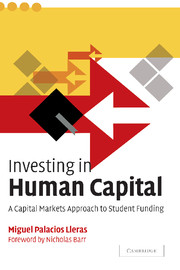Book contents
- Frontmatter
- Contents
- List of figures
- List of tables
- Foreword
- Acknowledgments
- Introduction
- Part I The problem of financing education
- Part II Equity-like investments to finance education
- 4 The evolution of human capital contracts
- 5 How human capital contracts work
- 6 The case for human capital contracts
- 7 Human capital options
- Part III Implementing human capital contracts
- Appendix A Valuation of human capital contracts
- Appendix B Using human capital options to value income-contingent loans
- Appendix C Features of human capital contracts, income-contingent loans, and traditional mortgage-type loans
- Appendix D A developing country study
- Notes
- References
- Index
5 - How human capital contracts work
Published online by Cambridge University Press: 08 January 2010
- Frontmatter
- Contents
- List of figures
- List of tables
- Foreword
- Acknowledgments
- Introduction
- Part I The problem of financing education
- Part II Equity-like investments to finance education
- 4 The evolution of human capital contracts
- 5 How human capital contracts work
- 6 The case for human capital contracts
- 7 Human capital options
- Part III Implementing human capital contracts
- Appendix A Valuation of human capital contracts
- Appendix B Using human capital options to value income-contingent loans
- Appendix C Features of human capital contracts, income-contingent loans, and traditional mortgage-type loans
- Appendix D A developing country study
- Notes
- References
- Index
Summary
As explained in chapter 4, human capital contracts (HCCs) are contracts in which an individual commits part of her future income for a specified period of time in exchange for capital for financing her education. This chapter discusses how these contracts would work.
HCCs require students to commit future earnings and yet, because the underlying philosophy is never to interfere with the student's free will, contracts should be signed only by individuals of legal maturity capable of making such choices for their future and future earnings. This condition excludes elementary and high-school students, since children are not recognized in most legal systems as valid parties to a contract. But creating financial alternatives for low-income students in their early years is of crucial significance. A possible alternative is discussed in chapter 10.
The description of how HCCs would work applies mostly to countries with developed financial markets. The basic features should be universal, in theory. However, countries with less developed financial markets will probably not witness the full development of HCCs as described in this chapter. Alternatives for implementing HCCs where local circumstances prevent their development based solely on private initiatives are discussed in chapter 10.
Basic features: the contract
The basic terms of an HCC specify what the student and the investor can expect from each other, the percentage of income that a student commits, and the amount of time that her obligation lasts.
- Type
- Chapter
- Information
- Investing in Human CapitalA Capital Markets Approach to Student Funding, pp. 53 - 68Publisher: Cambridge University PressPrint publication year: 2004



